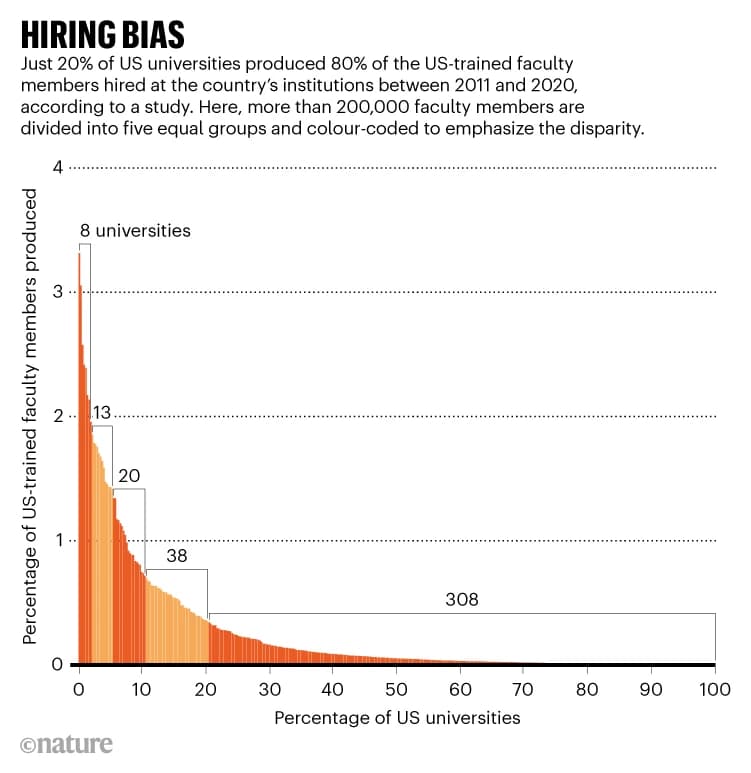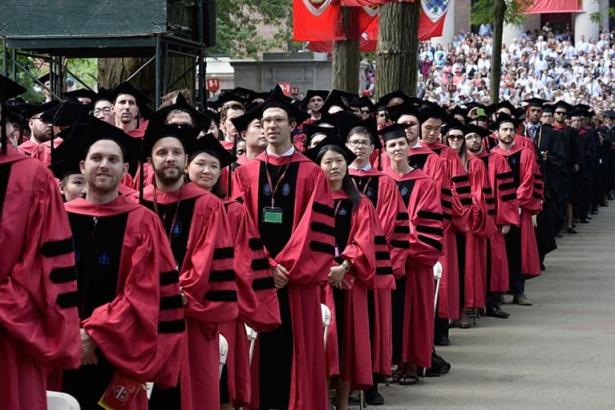US universities hire most of their tenure-track faculty members from the same handful of elite institutions, according to a study1. The finding suggests that prestige is overvalued in hiring decisions and that academic researchers have little opportunity to obtain jobs at institutions considered more elite than the ones at which they were trained.
Specifically, the study, published in Nature on 21 September, shows that just 20% of PhD-granting institutions in the United States supplied 80% of tenure-track faculty members to institutions across the country between 2011 and 2020 (see ‘Hiring bias’). No historically Black colleges and universities (HBCUs) or Hispanic-serving institutions (HSIs) were among that 20%, says Hunter Wapman, a computer scientist at the University of Colorado Boulder (CU Boulder) and a co-author of the paper. One in eight US-trained tenure-track faculty members got their PhDs from just five elite universities: the University of California, Berkeley; Harvard University in Cambridge, Massachusetts; the University of Michigan in Ann Arbor; Stanford University in California; and the University of Wisconsin–Madison.
“It’s not surprising, but it is jarring” to see these data, says Leslie Gonzales, a social scientist who studies higher education at Michigan State University in East Lansing. “There’s so much brilliant work and training of brilliant scholars that’s happening outside of this tiny sliver” of institutions, including at HBCUs and HSIs — and it’s being overlooked, she says.

Source: Ref 1.
This picture of elitism is bolstered by a study published last month in Nature Human Behaviour2, showing that almost 25% of faculty members in the United States have at least one parent with a PhD (in the general population, less than 1% of people have a parent with a PhD). That’s significant because parents with advanced degrees tend to have higher socio-economic status than do those without such education, so upper-class families are contributing heavily to the PhD pipeline, says Aaron Clauset, a computer scientist at CU Boulder and co-author of both papers.
Together, the studies portray an academic system in which most faculty members are trained at a few universities, and academic researchers generally come from families with similar backgrounds, setting up a cycle of sameness. “Is the system a meritocracy?” asks Daniel Larremore, a computational scientist at CU Boulder who is a co-author of both papers. “In peer review, no; in the spread of ideas, no; and in faculty hiring, surely no.”
Measuring excellence
The Nature paper’s data set included tenured and tenure-track faculty members who worked at PhD-granting institutions in the United States between 2011 and 2020, for a total of 295,089 people at more than 350 institutions. The data came from the Academic Analytics Research Center based in Charlotte, North Carolina, which offered Larremore and the team access to the information. Larremore, Wapman and their colleagues sorted faculty members from the data set into 107 fields, such as ecology and chemistry.

Related: Revealed: the pay bump for being a straight, white man in US science
Depending on the field, only 5–23% of faculty members worked at an institution more prestigious than the one at which they earned their PhD, according to the analysis. Fields with the least ‘upward mobility’ included classics and economics, whereas those with the most included animal science and pharmacology.
Hiring committees seem to be using prestige as a proxy for excellence on the job, says Kimberly Griffin, dean of the College of Education at the University of Maryland in College Park. But ‘prestige’ does not necessarily indicate ‘better-qualified’, and prestigious graduate programmes often admit students on the basis of standardized test scores, letters of recommendation and the renown of their undergraduate degree. All of these, research shows, can disadvantage students of colour, says Griffin, who is also editor of the Journal of Diversity in Higher Education.
“Accepting that prestige is a good measure of excellence means that we’re not looking into the history of how things became prestigious,” Gonzales says. The founding of elite US universities is “intertwined with exclusion”, she adds. For instance, many institutions have a history of seizing land from Indigenous groups, or originally derived their wealth from or supported their infrastructure with the labour of enslaved Black people.
Learning from the data
The Nature paper found that the proportion of new recruits who are women has remained flat since 2011 in 100 of the 107 fields analysed — and actually decreased in the remaining 7. The overall percentage of women did increase in three-quarters of the fields, but the authors attribute this to a high proportion of men among faculty members who reached retirement age. These trends indicate that efforts to hire more women in academia have not been fruitful, at least since 2011, Larremore says.

Related: Women less likely to win major research awards
He does note two limitations of the gender data set: the team mostly used name–gender cultural associations to categorize faculty members as men or women, which is not necessarily reliable; and there was no non-binary gender category.
The Nature Human Behaviour study used an online survey to gather data from 7,024 tenure-track faculty members in the United States. Clauset has been surprised by how many people have contacted the team about the paper since its publication. “I don’t think we realized how much it would resonate with people in their lived experiences,” he says. Many people who are ‘first generation’ graduate students from families without advanced degrees have said that they feel set apart from their peers who have had more of an advantage, he adds.
There are ways in which academia could de-emphasize prestige and reduce inequalities. The first, basic step is questioning prestige and where it comes from, Gonzales says. She advises hiring committees to list all the places they plan to advertise a position, including their personal connections; examine the institutional diversity of the list; and add HBCUs, HSIs and regional institutions if they are not already included.
Unequal access to faculty jobs across gender, race and socio-economic background has consequences. “There is a huge amount of literature that says who is in the scientific community affects what research questions are asked,” Clauset says. “By not being as diverse as we could be, as inclusive as we could be, we are losing smart people who could change the world for the better.”
doi: https://doi.org/10.1038/d41586-022-02998-w
References
-
Wapman, K. H., Zhang, S., Clauset, A. & Larremore, D. B. Nature https://doi.org/10.1038/s41586-022-05222-x (2022).
-
Morgan, A. C. et al. Nature Hum. Behav. https://doi.org/10.1038/s41562-022-01425-4 (2022).
Anna Nowogrodzki is a freelance science journalist and former plant biologist. Her writing can be found in National Geographic, New Scientist, and Nature, among others, and she can be found in the Boston area on her bicycle.


Spread the word